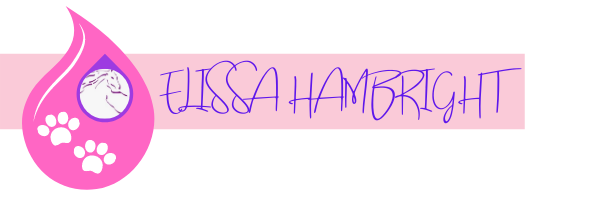
As pet owners, we constantly seek ways to enhance the well-being of our furry companions. Essential oils have garnered attention for their wellness properties and natural benefits, not only for us but also for our dogs. However, before delving into the world of aromatherapy for our canine friends, it's crucial to understand the dos and don'ts of using essential oils for dogs. While these oils can offer various advantages, improper use may pose risks to our pets. In this blog post, we will explore the essential guidelines for safely using essential oils with dogs, ensuring that their health and happiness remain a top priority. By gaining insight into the appropriate usage and pet-safe oils, we can create a harmonious and beneficial aromatic environment for our beloved four-legged companions.
1. The Dos of Using Essential Oils for Dogs
When used correctly, essential oils can provide various wellness benefits for dogs. Here are some essential dos to keep in mind:
a) Consult A Holistic Veterinarian Familiar And Trained In Aromatherapy: When it comes to using essential oils for your furry companion, consulting a holistic veterinarian trained and experienced in the art of aromatherapy can make a significant difference. Unlike regular vets who might dismiss essential oils without understanding their potential benefits, a holistic veterinarian possesses specialized knowledge of natural therapies and their applications in pet care. These experts understand the intricacies of essential oils, including their chemical properties, appropriate dilution ratios, and suitable oils for specific conditions. By seeking guidance from a holistic veterinarian, you can ensure a tailored and safe approach to using essential oils for your pet's well-being, making informed decisions that promote their health and happiness. Their expertise allows you to explore the world of aromatherapy for your pet with confidence and peace of mind.
b) Choose High-Quality Pure Essential Oils: Quality matters when it comes to essential oils. Opt for pure, premium essential oils that are free from additives or synthetic ingredients. Low-quality oils may contain harmful substances that can be toxic to dogs.
c) Proper Dilution: Essential oils boast incredible concentration; for instance, it takes approximately 27 square feet of lavender plant to produce a mere 15 ml bottle of lavender essential oil. Due to this potent concentration, diluting essential oils offers numerous benefits. Firstly, it allows us to use the smallest amount necessary to achieve the desired effect. Additionally, diluted oils can be applied over larger surface areas, reducing the risk of skin reactions. Moreover, the dilution process enables the essential oil to stay on the skin for a longer duration, countering the rapid evaporation typical of highly volatile oils. By slowing down the absorption rate, we facilitate the body's safe and efficient processing of the essential oil. Embracing proper dilution practices ensures a harmonious and secure experience when utilizing essential oils for our fur kids well-being.
d) Start Slowly and Observe: When introducing essential oils to your dog, start with low concentrations aromatically and observe their response. Some dogs may be more sensitive than others, so it's essential to monitor for any signs of discomfort or adverse reactions. For more tips on getting started using essential oils aromatically with your dog, click HERE.
e) Monitor Behavioral Changes: Keep an eye on your dog's behavior after using essential oils. If you notice any abnormal signs, such as excessive drooling, lethargy, stupor, or even vomiting, discontinue use immediately and remove your dog from the area.
f) Use Pet-Safe Oils: Read your labels and avoid buying products where the label advises against use with pets. Not all essential oils are created equally. A pure and premium essential oil, properly diluted, can be safe for dogs. Get to know your essential oil company and if they can't answer yes to the following questions, they may not have a pure product:
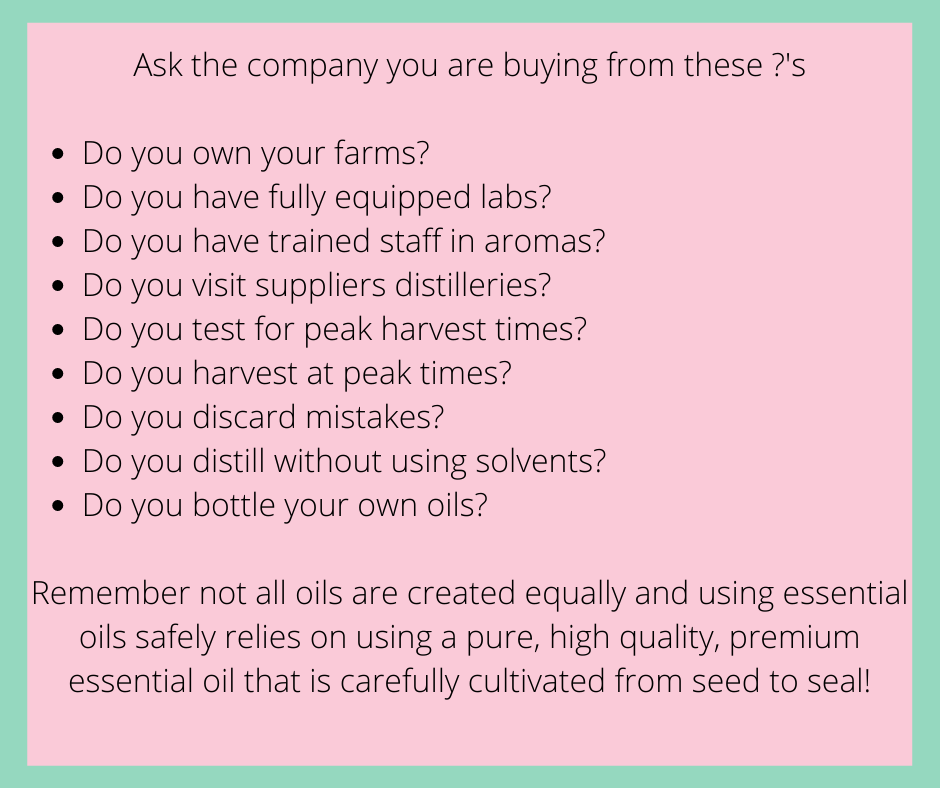 When you are just getting started, stick to well regarded pet-safe oils like lavender, copaiba, or frankincense, which are generally well-tolerated by dogs.
When you are just getting started, stick to well regarded pet-safe oils like lavender, copaiba, or frankincense, which are generally well-tolerated by dogs.2. The Don'ts of Using Essential Oils for Dogs
While essential oils can be beneficial for dogs, there are several important don'ts to be aware of:
a) Don't Force essential oils on your dog: Start low and go slow! Offer the essential oil bottle to your dog and see how they react. Dogs have a much greater sense of smell than we do and they are getting a whiff even with the lid on!
b) Don't Apply Undiluted Oils: Undiluted essential oils can be too much for your dog. It's generally best to always dilute essential oils properly before applying them to your dog's skin or fur.
c) Don't Overdo It: Moderation is key when using essential oils for dogs.Essential oils work better with a small amount more frequently. Allow your dog an 'out'. Let them choose to leave the aroma if they'd like.
d) Avoid Sensitive Areas: Dogs have more sensitive noses than humans, so generally it's best to avoid applying essential oils around their head unless you are using them for something specific. Also, avoid applying directly to their eyes, nose, mucous membranes, or genitals.
e) Don't buy essential oils from a company you haven't researched and know, like, and trust: Not all essential oils are created equally. Unfortunately many essential oils on the market today are adulterated. There is little regulation in the industry and other factors such as the actual growing of the plant, harvesting, and distillation all contribute to whether a pure essential oil comes out the other side. Be sure to research where and whom you are buying your essential oils from.
Essential oils can offer a wealth of benefits to us and our fur kids when used properly. Remember to consult your holistic veterinarian, choose pet-safe oils, dilute properly, and closely observe your dog's response. By following the dos and don'ts outlined in this blog post, you and your dog can enjoy all the benefits that essential oils bring to the table.
Wondering where I get my 100% pure and premium essential oils? Click HERE to explore Young Living™ Essential Oils. With Young Living, you can experience the benefits of high-quality essential oils and infused products backed by their Seed to Seal® promise, ensuring purity, potency, and sustainability. Start your aromatic adventure today and discover the world of pure, premium, and authentic essential oils from Young Living. Click HERE to learn more! (This is an affiliate link and I earn a small commission from your order at no cost to you. Thanks for supporting my small business! I'm so excited to help you get started, that I'll connect with you once you order and send you something special!)
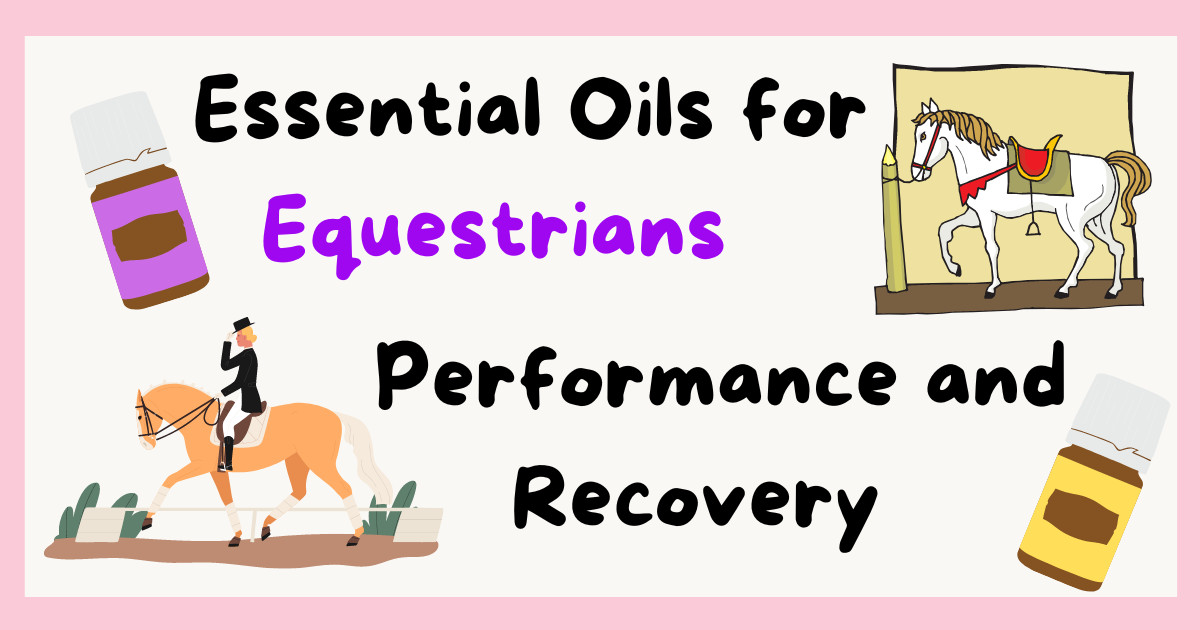
As equestrians, we always strive to provide the best care for our horses, ensuring their well-being and peak performance. While there are numerous methods and supplements available to support their health and performance, one natural option that has gained popularity is the use of essential oils. Derived from plants, essential oils can offer a wide range of benefits for both humans and animals alike. In this blog post, we'll delve into the world of essential oils for equestrians, exploring how these natural remedies can enhance the performance and aid in the recovery of our beloved equine partners.
1. Understanding Essential Oils
Before diving into the specific benefits of essential oils for horses, let's start by understanding what essential oils are. Essential oils are concentrated plant extracts that capture the beneficial properties of various botanicals. They are obtained through processes such as steam distillation or cold-press extraction, resulting in highly potent and aromatic substances. Did you know that it takes an average of 75 lemons to produce one 15 ml bottle of lemon essential oil! Each essential oil possesses unique chemical compounds that contribute to its specific wellness effects.
2. Promoting Relaxation and Reducing Tension
One of the key benefits of essential oils for horses is their ability to promote relaxation and reduce tension. Equestrian activities can be demanding and stressful for our equine companions, leading to tension and unease. Essential oils such as lavender, chamomile, cedarwood, and vetiver are known for their calming properties. By wearing these essential oils as a perfume, we can become a walking diffuser promoting calmness and relaxation. Horses are a partnership and we are half of the equation, so anything we can do to keep our emotions in check and on the positive side will support our horses. We can also diffuse these essential oils in the barn and even apply them topically. To dive more in depth on using essential oils to help calm you and your horse, click HERE.
3. Supporting Respiratory Health
Maintaining healthy respiratory function is crucial for the performance and overall well-being of horses. Essential oils like eucalyptus, peppermint, and tea tree have been studied for their possible expectorant and decongestant properties, making them an ideal choice to support the respiratory system. This study supports the inhalation of eucalyptus in "reducing airway inflammatory parameters". Inhalation of these essential oils may help maintain healthy airways and enhance breathing capacity, ultimately benefiting the horse's performance during intense workouts or competitions.
4. Enhancing Focus and Mental Clarity
Achieving optimal focus and mental clarity is vital for both the rider and the horse in equestrian disciplines. Certain essential oils, such as rosemary, lemon, and frankincense, are known for their ability to enhance cognitive function and promote alertness. These clinical trial results, published on PubMed.gov, found that "rosemary produced a significant enhancement of performance for overall quality of memory and secondary memory factors". By incorporating these essential oils into grooming routines or using them during training sessions, we can help our horses maintain focus and concentration. As riders, a sharp mind can help improve our performance and memory for dressage tests or obstacle courses! An easy way to incorporate this is by making a roller bottle. Then, you can roll a small amount onto your hand when grooming and offer it to your horse. Next, you can apply the leftovers to the back of your neck. For a step by step guide to making a roller ball, click HERE.
5. Supporting Muscle Recovery and Joint Health
The physical demands placed on horses during training and competition can lead to muscle soreness and joint discomfort. Essential oils like peppermint, copaiba, helichrysum, and wintergreen possess properties that can aid in muscle recovery and support joint health. Topical application of these oils, either through massage or liniments, can help alleviate discomfort, reduce tension, and support the horse's recovery process. This study, found on PubMed.gov, concluded "that the anti-inflammatory activity of Helichrysum italicum can be explained by multiple effects, including inflammatory enzyme inhibition, free-radical scavenging activity and corticoid-like effects."
This randomized controlled trial, on PubMed.gov, reports that "Peppermint and its active ingredient menthol have long been used for the treatment of various pain conditions including headache." One of my favorite things to do for my horse after a workout is to rinse them with a peppermint brace. This is cooling and refreshing and may soothe fatigued muscles. For the recipe and other easy ways to use peppermint oil, click HERE.
6. Ensuring Safety and Proper Usage
While essential oils offer numerous benefits, it is crucial to prioritize the safety of our horses. Here are a few important considerations when using essential oils:
a. Quality: Choose high-quality, pure and premium essential oils from reputable sources to ensure their potency and effectiveness. (If you're curious about where I source my essential oils, I highly recommend joining me on a journey with Young Living™. Their unwavering commitment to quality, sustainability, and purity through their Seed To Seal™ process makes them my top choice.)
b. Dilution: Essential oils should be properly diluted before application to avoid skin irritation or sensitization. Using carrier oils such as coconut oil or jojoba oil for dilution, as well as incorporating the essential oil into natural products, will minimize potential sensitivities. It's always best to operate with the "less is more" mentality and observe your horse closely for any negative reactions. If any are noticed, usually the application of more carrier oil is sufficient to reduce the reaction.
c. Patch Testing: Before applying any essential oil to a larger area, perform a patch test on a small area of the horse's skin to check for any adverse reactions.
d. Professional Guidance: Consult with a holistic veterinarian familiar with essential oils or equine aromatherapist for personalized advice and guidance on essential oil usage, especially if your horse has any pre-existing health conditions.
It is important to note:
When participating in competitive events, you will want to exercise caution when using essential oils topically, as certain governing bodies may impose regulations on their usage. To avoid potential issues, a simple and effective alternative is to harness the benefits of essential oils through inhalation only. Inhaling the aromatic compounds of essential oils, without topical use, will still positively impact mood, focus, and overall well-being. In fact, this study, found on PubMed.gov, found that "lavender oil inhalation decreases pain levels of children." Simply inhale from the bottle, allow your horse to inhale from the bottle, then you can wear topically as a perfume. When you are wearing the essential oil as a perfume, your horse will benefit from the aroma as well. You and your horse can experience the effects of essential oils without the need for direct skin application, ensuring compliance with regulations and promoting a healthy competitive spirit.
Incorporating essential oils into the equestrian routine can be a natural and effective way to enhance the performance and aid in the recovery of horses. From promoting relaxation to supporting respiratory health, enhancing focus, and aiding in muscle recovery, essential oils offer a wide range of benefits.
However, it is essential to prioritize the safety and well-being of our equine partners by using high-quality oils, proper dilution, and seeking professional guidance when needed.
By embracing the power of nature through essential oils, equestrians can create a harmonious and supportive environment for their horses, leading to improved performance, enhanced well-being, and a deeper connection between rider and horse.
Ready to take your knowledge of essential oils and horses to the next level? Dive deep into the world of essential oils and horses with my beginner course, "Oily Horse Intro." Gain a thorough understanding of what essential oils are, where and when to use them, how to apply them effectively, and why they are beneficial for your equine companion.
Don't miss out on this opportunity to become a confident and knowledgeable essential oil user.
Click this link today and enroll in "Oily Horse Intro" Your equine partner deserves the best, and you have the power to provide it. Take action now and embark on this transformative journey together!
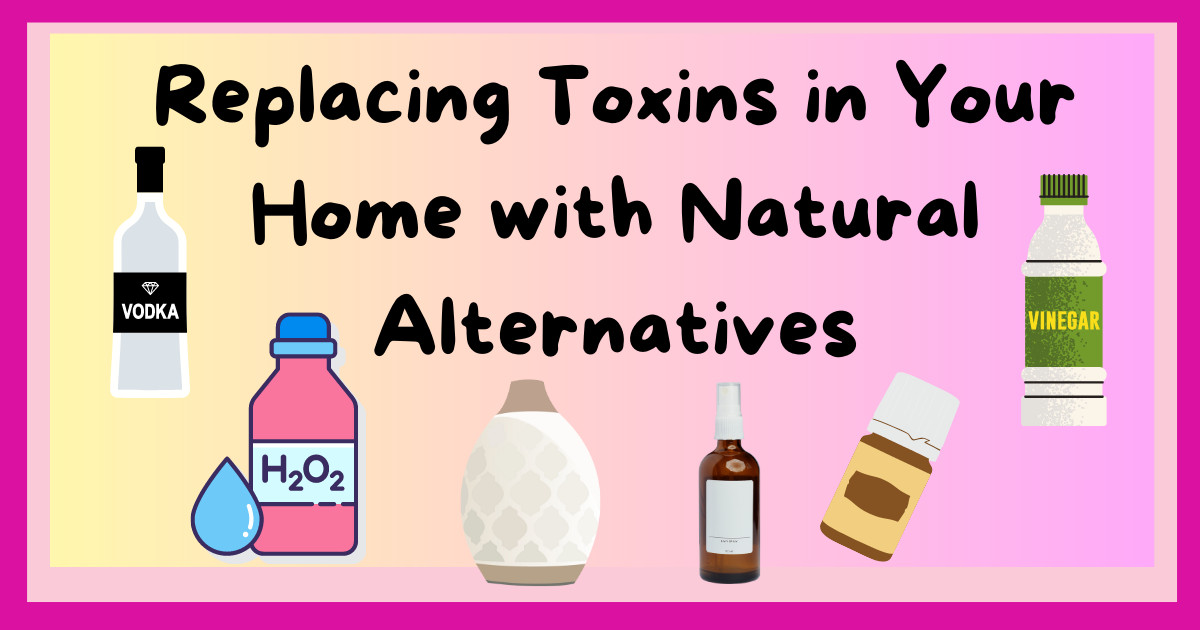
In today's fast-paced world, it's crucial to prioritize the well-being of our beloved canine companions. One area that often goes overlooked is the impact of toxins present in our homes, including cleaners, air fresheners, and other household products. These products can not only harm humans but also affect the health and well-being of our four-legged friends. Fortunately, there are less harmful products we can use, including essential oils, to offer a natural and safe alternative to these harmful substances. In this blog, we will explore the benefits of using natural products and essential oils for canine wellness and how easy it is to replace toxic household products with more natural alternatives. By doing so, we can create a healthier and safer environment for both ourselves and our furry companions.
Understanding the Dangers of Common Household Cleaners and Air Fresheners
To fully appreciate the importance of transitioning to natural alternatives, it's essential to understand why common household cleaners and air fresheners pose a risk to people and dogs alike. Many commercial products contain toxic chemicals such as ammonia, bleach, formaldehyde, and phthalates, which can lead to respiratory issues, skin irritations, hormonal disruptions, and even cancer. Dogs are particularly vulnerable as they often lick or sniff surfaces treated with these chemicals, exposing themselves to harmful toxins. Additionally, they spend their lives much closer to the floor where common toxic household products can live from cleaning. In many households, our dogs spend much more time inside the home than we, as owners do, since we're off to work for the day. This can make them more susceptible to the adverse effects of these products.
Common Myths About Natural Cleaners
Common myths often circulate around the use of natural household cleaners versus chemical cleaners.
Myth #1: Natural cleaners are less effective than chemical cleaners.
- Fact: Several products on the market today can offer a safer alternative to clean with. Plain ol' soap and water, vinegar, hydrogen peroxide, and alcohol have long been used to clean and disinfect surfaces. According to this article published by the CDC, "Published reports ascribe good germicidal activity to hydrogen peroxide and attest to its bactericidal, virucidal, sporicidal, and fungicidal properties". The addition of essential oils can add wellness benefits as well. The Antimicrobial effects of Tea Tree, a popular essential oil that many people like to add to their home cleaning products, has been studied on PubMed.gov.
Myth #2: Natural cleaners are expensive and hard to find.
- Fact: Essential oils and other natural ingredients are often affordable and readily available in local stores or online. After the initial purchase and investment of ingredients for DIY's, many natural homemade cleaners are less expensive in the long run. If you're not into DIY, check out my favorite toxin free cleaner, Thieves™ Household Cleaner concentrate, from Young Living™ Essential Oils. One bottle of concentrate can make over 20 quarts of cleaner, making it one of the least expensive toxin free cleaners on the market!
Myth #3: Natural cleaners lack a pleasant scent.
- Fact: The addition of essential oils offers a wide range of fragrances, such as lavender and citrus, providing a delightful aroma while effectively cleaning your home. Some alcohols that you can use for cleaning have no aroma at all.
Dispelling these myths can help pet owners and families make informed choices in opting for safer, more natural alternatives for their homes. To make it easy, I've got an 'Essential Cleaning Supplies Checklist' so you can grab the products you need to get started. Click HERE!
Benefits of Essential Oils for Canine Wellness
Essential oils, derived from plants, offer numerous benefits for canine wellness. They are natural, biodegradable, and free from harmful chemicals. When used correctly, essential oils can promote relaxation, reduce tension, support healthy skin, and enhance overall well-being. Essential oils can also be used for odor, making them ideal for various household applications. Some essential oils can even be used for outdoor and indoor annoyances, helping to keep unwanted critters at bay. This study on PubMed.gov, found essential oil vapors "effective in reducing microbial contamination". They can add a wellness and cleaning boost to your natural products. In fact, many 'natural' cleaners on the market today include essential oils.
Essential Oil Safety Guidelines for Canine Wellness
While essential oils have numerous benefits, it's important to use them safely around dogs. The two most important factors when using essential oils around dogs are quality and dilution. To learn how to make sure you are using a pure, high quality, and premium essential oil, click HERE. When you are adding essential oils to, or making your own cleaners, you'll already be diluting the essential oil for safe use in the home.
Replacing Toxic Cleaners with Essential Oil-Based Alternatives
Transitioning to toxin free cleaners can be simple and easy. Here are some popular household cleaning products you can use:
- Vinegar
- Baking Soda
- Liquid Castile Soap
- Vodka
- Hydrogen Peroxide
- Essential Oils
1. All-purpose cleaner: Mix half water and half vinegar, and add several drops of essential oils like lemon or tea tree oil for a safe and effective all-purpose cleaner that can be used on countertops, floors, and other surfaces. Yes, you can use tea tree oil around your dogs, click HERE for what you need to know. If you have natural stone, granite, or marble, vinegar isn't recommended as it can scratch and dull the countertop, and affect the sealers. You will want to use plain ol' soap and water. For more in depth info on using natural cleaners specifically, check out my 'Healthy Hacks To Clean Your Home' article by clicking HERE!
2. Air freshener: Instead of using aerosol sprays or plug-in air fresheners, consider making your own natural alternatives. You can easily make a room spray with essential oils. Click HERE for a step by step guide to making a spray. Consider an investment of an essential oil diffuser. Placed strategically in your home, adding several drops and diffusing daily can be a perfect way to uplift and freshen your home. There are many diffusers on the market today, for help in picking out the right one for you, check out my blog HERE!
3. Odor control: To combat unpleasant odors, baking soda can be your new BFF.
You can add essential oils to baking soda and make closet and drawer sachets as well as standing air fresheners around your home. For more easy ways and ideas to replace chemical laden air fresheners, check out my 'Ultimate Guide To Eliminating Pet Odors Naturally' by clicking HERE!
4. Carpet cleaner: Add about 20-30 drops of an essential oil or blend to 1 cup of baking soda. Mix well and then sprinkle on carpet you have already vacuumed. Let sit for about 10-15 minutes or even overnight for heavily soiled areas, then vacuum up.
5. Mop water: Add around 10 drops of essential oils like lemon, pine, or lavender to your mop water for a natural and refreshing scent while cleaning your floors.
6. Bleach and Hand Soap: For my favorite bleach alternative and hand soap recipes, click HERE. Sometimes its easy to think that your exposure to chemicals isn't that big, but how many times do you wash your hands each day? We may not realize it, but with each hand wash and product use, we accumulate a significant chemical load. Moreover, products labeled with "fragrance" can hide a multitude of chemicals, as they are protected by 'trade secret' laws and may contain hundreds of undisclosed substances. Making your own natural alternatives empowers you to lead a healthier, chemical-free lifestyle for you, your furry friend, and the planet.
7.Window and Mirror Cleaner: Click HERE to learn how to make an all-natural window and mirror cleaner using just four ingredients, ensuring a streak-free shine while promoting a healthier living environment for you and your furry friend.
By replacing toxic household products with natural alternatives, we can create a safer and healthier environment for both ourselves and our canine companions. Essential oils offer a versatile and effective solution to eliminate harmful chemicals from our homes while promoting canine wellness. With a little knowledge and effort, you can easily make the switch and experience the benefits of essential oils for your home and your furry friend's well-being.
If you're curious about where I source my essential oils, I highly recommend joining me on a journey with Young Living™. Their unwavering commitment to quality, sustainability, and purity through their Seed To Seal™ process makes them my top choice. Explore the Thieves™ product line, a perfect addition to creating a natural home environment. Embracing safe and toxin-free cleaning products has never been easier. If you prefer not to DIY, Young Living™ offers a complete product line ideal for cleaning your home. Check out the Make a Shift™ Happy, Healthy Home™ Kit HERE. This kit is all you need to get started with natural home cleaning today!(This is an affiliate link, and I earn a small commission from your order at no extra cost to you. Thank you for supporting my small business! I'm thrilled to assist you in getting started and will connect with you after your order to send something special your way!)
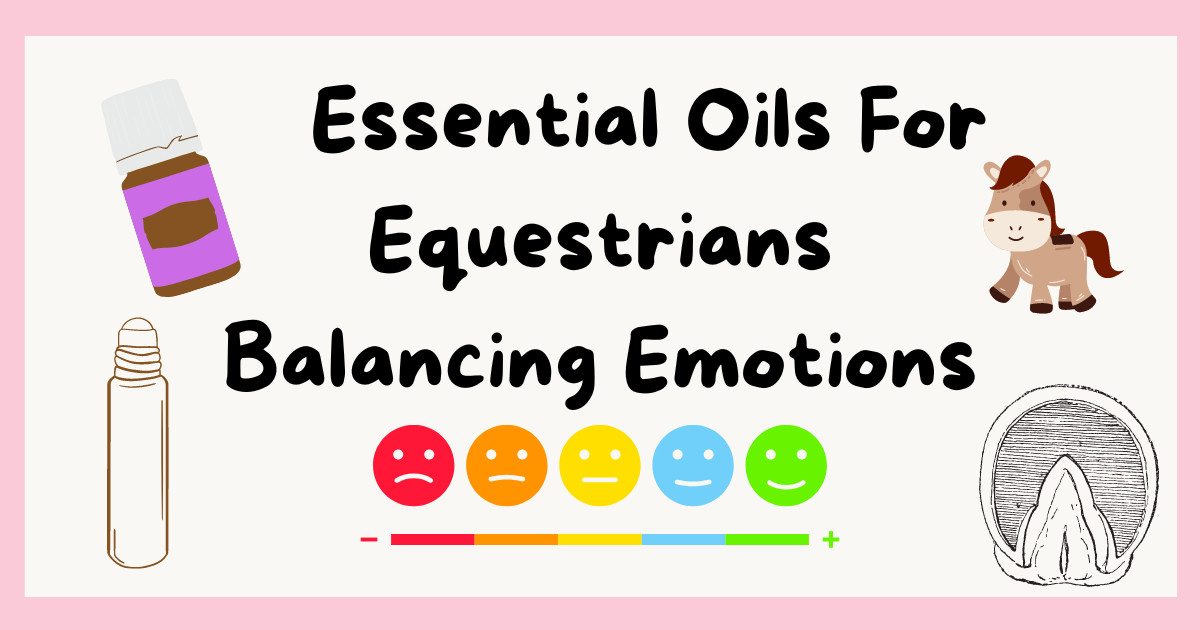
In the world of equestrian sports, I believe the rider's emotional state can be just as crucial as the physical well-being of the horse. As riders, we strive to provide the best support and care for our equine partners, and one way to achieve this is by balancing our own emotions. Essential oils offer a natural and effective means to harmonize our emotional well-being, allowing us to be at our best when supporting our horses. In this blog post, let's explore the power of using essential oils to help balance our emotions and maintain optimal mental health when we are at the barn. We are half the equation and when we are balanced, it helps our horses be balanced!
First lets understand what essential oils are and why we can use them to affect our emotions.
Essential oils are concentrated plant extracts that capture the beneficial properties of various botanicals. They are obtained through processes such as steam distillation or cold-press extraction, resulting in highly potent and aromatic substances. Each essential oil possesses unique chemical compounds that contribute to its specific aroma and wellness effects.
Plants produce essential oils as a defense mechanism and to support their own well-being. Essential oils are found in various parts of plants, including leaves, flowers, bark, and roots. These aromatic compounds serve multiple purposes for plants, such as attracting pollinators, repelling pests and pathogens, and combating environmental stressors. Essential oils can deter insects and herbivores with their strong scents, preventing damage to plant tissues and ensuring survival. Additionally, these oils can inhibit the growth of harmful microorganisms and provide protection against fungal or bacterial infections. In some cases, essential oils play a role in plant communication, allowing them to send signals to neighboring plants or attract beneficial organisms.
What Does This Mean For Us?!
The fact that plants produce essential oils as a defense mechanism and for their own well-being holds great significance for us as humans. Through our understanding and utilization of these natural aromatic compounds, we can harness their benefits for our own well-being and support. Just as essential oils serve plants, they can offer similar advantages to us.
Why Do Essential Oils Affect Our Emotions?
The sense of smell is intricately connected to our emotions and memories. When we inhale the aroma of essential oils, the molecules stimulate the olfactory system, which is directly linked to the brain's limbic system—the center of emotions and memories. This direct connection allows essential oils to have a profound impact on our emotional state. Each essential oil contains unique chemical compounds that can trigger specific emotional responses. For example, the scent of lavender is known for its calming and relaxing properties, while citrus oils like grapefruit and lemon are uplifting and energizing. By inhaling the aroma of these oils, we can activate neurotransmitters and receptors in the brain, promoting the release of certain chemicals that help balance our emotions. This process provides a natural and non-invasive way to influence our emotional well-being, allowing us to create a positive and supportive environment for ourselves and our equine partners.
The Role Of Emotions In Equestrian Performance
Emotions have a profound impact on our ability to connect with and guide our horses. Stress, Anxiety, tension, or distraction can hinder our communication and negatively affect our performance. It can make our bodies tight and unable to perform their best. Conversely, a calm and focused mindset can promote trust, confidence, and synchronization with our equine partners. Have you ever had a riding lesson and your instructor reminded you to breathe, and then magically everything got better, I have! Once you recognize the significance of your emotions and how they affect your horse when you interact with them, you can use an essential oil as a tool to help with emotional balance.
Ways We Can Use Essential Oils As Riders
There are various ways to enjoy the aromatic benefits of essential oils, allowing you to incorporate them seamlessly into your barn routine. One simple method is inhaling the aroma directly from the bottle, which can provide an immediate sensory experience and mood boost. Alternatively, you can create your own oil blend by adding essential oils to a roller ball and applying it to pulse points to wear as a perfume.
This is one of the safest and best ways to use essential oils with horses and even dogs, as you become a walking diffuser. You dont need to apply the essential oil to your skin for it to be effective for emotional support for your mind and body. To read more about that-click HERE
For a continuous aromatic experience, diffuser jewelry, such as necklaces or bracelets designed with absorbent materials, can be a stylish and effective option. You can add a drop of your favorite essential oil or blend essential oils together for a powerful aroma. These methods allow you to fully embrace the aromatherapy benefits of essential oils and carry their uplifting scents with you throughout the day.
Roller Ball Recipes For:
1. Promoting Tension Relief
Tension can manifest in both riders and horses, impeding performance and creating a stressful environment. To alleviate tension, essential oils such as grapefruit, lavender, Roman chamomile, and cedarwood, can be utilized. A roller ball recipe for a tension relief blend could include:
10 drops of Lavender essential oil
5 drops of Roman chamomile essential oil
5 drops of Frankincense essential oil
Add the essential oils to a 10ml roller bottle, then fill the rest with a carrier oil of your choice (such as fractionated coconut oil or jojoba oil).
Apply this blend to the pulse points or inhale it before riding to promote relaxation, ease muscle tension, and create a calmer atmosphere for both rider and horse.
2. Cultivating Calmness
Maintaining a sense of calmness is essential for riders to provide steady guidance and support. Essential oils such as cedarwood, frankincense, myrrh, and vetiver are known for their calming properties. For a calming blend, try:
10 drops of Cedarwood
5 drops of Frankincense
5 drops of Vetiver
Add the essential oils to a 10ml roller bottle, then fill the rest with a carrier oil of your choice (such as fractionated coconut oil or jojoba oil).
Apply this blend to the wrists and wear it as a perfume to promote a peaceful and centered state of mind.
3. Building Courage and Confidence
Fear and lack of confidence can hinder riders from fully realizing their potential. Essential oils such as Spruce, Fir, Juniper, and ylang-ylang can help boost courage and self-assurance. To create a courage-enhancing blend:
10 drops of Spruce essential oil
5 drops of Juniper essential oil
5 drops of Ylang Ylang essential oil
Add the essential oils to a 10ml roller bottle, then fill the rest with a carrier oil of your choice (such as fractionated coconut oil or jojoba oil).
Apply this blend to the solar plexus area or inhale it deeply before riding to instill a sense of courage, boldness, and assertiveness.
4. Enhancing Focus and Concentration
Focus and concentration are vital for clear communication and effective riding. Essential oils such as rosemary, lemon, and peppermint can help sharpen mental clarity and enhance focus.
10 drops of Rosemary essential oil
5 drops of Peppermint essential oil
5 drops of Lemon essential oil
Add the essential oils to a 10ml roller bottle, then fill the rest with a carrier oil of your choice (such as fractionated coconut oil or jojoba oil).
Apply this blend to the back of your neck after inhaling deeply to stimulate alertness, improve concentration, and promote mental acuity.
5. Managing Frustration and Impatience
Equestrian pursuits often come with challenges and setbacks, leading to frustration and impatience. Or we can simply be in an impatient mood after waiting all day to get to the barn. Essential oils such as clary sage, juniper, and sandalwood possess soothing properties to aid in frustration management. To create a blend for frustration relief:
10 drops of Clary Sage essential oil
5 drops of Juniper essential oil
5 drops of Sandalwood essential oil
Add the essential oils to a 10ml roller bottle, then fill the rest with a carrier oil of your choice (such as fractionated coconut oil or jojoba oil).
Apply this blend to the chest and inhale it deeply to promote emotional balance, release tension, and restore a positive outlook.
Emotional balance is a vital aspect of equestrian performance that I feel is often overlooked, and essential oils provide a natural and effective means to help achieve this balance. By utilizing essential oils and blends for tension relief, calmness, courage, focus, and frustration management, riders can enhance their emotional well-being and support their horses more effectively.
You don't have to create a blend either...simply pick one of the essential oils, open the bottle, inhale deeply and let your horse inhale deeply before you get on or work with your horse! Blends are fun to create and use throughout the day...but don't let creating a blend stop you from harnessing the power of essential oils at the barn!
You can also try diffusing a calming essential oil blend for a half hour before you head for the barn to let the stress of the day melt away from your body. This could be all it takes to work thru any negative emotions that might affect your time with your horse before they become a problem.
Discovering the potential of essential oils to foster a profound bond with our equine companions is a delightful and gratifying experience. As we harmonize on an emotional level, the journey towards a joyful and fulfilling partnership with our horses unveils itself effortlessly and with great enjoyment.
As an essential oil enthusiast who has experienced the transformative benefits firsthand, I invite you to join me in exploring the world of essential oils with Young Living. I personally recommend Young Living for their unwavering commitment to quality, sustainability, and purity through their Seed To Seal™ process. Discover the wide range of high-quality essential oils and oil-infused products they offer by clicking HERE and visiting their website. You'll find essential oils and blends perfect for equestrians, supporting your journey towards enhanced well-being for both you and your horse. Embrace the power of nature and unlock the potential of essential oils with Young Living today. Let's embark on this aromatic adventure together! (This is an affiliate link and I earn a small commission from your order at no cost to you. Thanks for supporting my small business! I'm so excited to help you get started, that I'll connect with you once you order and send you something special!)
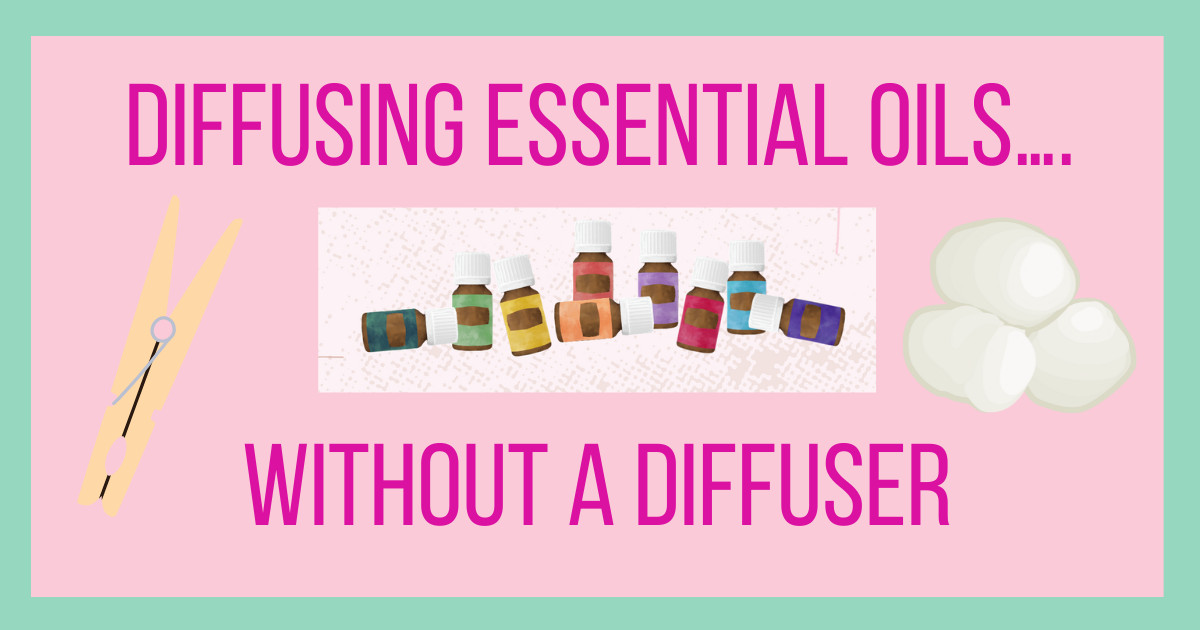
As a pet owner, essential oils can be a valuable tool for creating a calm and soothing environment, managing odors, and balancing emotions within your household and barn! One effective way to achieve this is by diffusing essential oils. My favorite way is with an ultrasonic diffuser, but did you know there are many ways you can diffuse essential oils without a 'diffuser'? Lets dive in and see how easy it is to use essential oils to transform your home or barn environment, whether you have a traditional diffuser or not!
Understanding Essential Oils and the Benefits of Diffusing
Essential oils are highly concentrated plant extracts that capture the plant's aroma and beneficial properties. These oils have been used for centuries in aromatherapy to promote physical and emotional well-being. When diffused, essential oils release their aromatic molecules into the air, allowing us to experience their wellness effects through inhalation.
Diffusing essential oils offers several benefits, both for humans and our animal companions. Some of my favorite advantages include:
1. Promotes Relaxation: Certain essential oils, such as lavender and chamomile, are known for their calming properties. Diffusing these oils can create a peaceful atmosphere, helping to reduce stress and tension in both pets and humans.
2. Cleanses the Air: Many essential oils possess odor controlling properties, which can help purify the air by eliminating and neutralizing smells.
3. Supports Respiratory Health: Some essential oils, like eucalyptus and peppermint, have properties that can aid respiratory health. Diffusing these oils may help promote good breathing.
4. Enhances Focus and Concentration: Essential oils like rosemary and peppermint can help improve mental clarity and focus. Diffusing these oils while working, studying, or during horse training sessions can enhance productivity.
Tips for Diffusing Essential Oils without a Diffuser
While traditional diffusers are convenient, there are alternative methods to enjoy the benefits of essential oils even without one. Here are some pet-safe techniques for diffusing essential oils:
1. Open Bottle Method: This method is a straightforward approach to enjoying the benefits of essential oils. To experience their aromatic properties, all you have to do is inhale the aroma. Essential oils are highly volatile, meaning that when you open the bottle, their molecules disperse into the air. They actually diffuse themselves-lol. When it comes to your horses and dogs, you can simply allow them to smell the essential oil directly from the bottle.
For dogs, you can unscrew the cap of the essential oil bottle and place it on the counter. This approach is particularly useful if your dog is not accustomed to essential oils or if you prefer to introduce an aroma temporarily. In the long run, it’s advisable to use a different method to prevent your essential oil from oxidizing or evaporating. With dogs incredible sense of smell, they can receive the benefits oftentimes without even taking the lid off.
2.Tissue or Cotton Ball Method: This is a simple and cost-effective way to diffuse essential oils. Apply a few drops of your chosen oil onto a tissue or cotton ball and place it in strategic areas around the house. Ensure your pet has the option to move away from the aroma if they find it overwhelming. This can also work well for trailering horses. Use a calming essential oil like lavender, cedarwood, or vetiver, and stash a couple of cotton balls in the trailer.
3. Air Filter: Apply 5-10 drops to your air filter when you change it out. Use your favorite or try eucalyptus, lemon, or lemongrass!
4. Spray Bottle Method: Dilute your essential oils in water and use a spray bottle to mist the air. This works well for odor control. I like to make one with lemon essential oil and keep it in my tack room. Say no to sweaty horse and leather smell -lol! For a step by step guide to making a room spray, click HERE.
5. Aromatherapy Jewelry: Consider wearing aromatherapy jewelry, such as a diffuser necklace or bracelet, infused with essential oils. The heat from your body will gently release the aroma throughout the day, providing a subtle and personal diffusion experience. This is also one of the best ways to use essential oils with your horses and dogs, especially if you are just starting out. You become a walking diffuser and you are also half the equation. When you are calm, happy and balanced, your horses and dogs are more likely to be too!
6. Ceramic or Clay Diffusers: Look for porous ceramic or clay objects, such as a decorative dish or diffuser stone. Add a few drops of essential oil onto these objects, and the porous material will slowly release the aroma into the air.
7. Dryer Balls: Adding several drops of essential oils to dryer balls will impart a lingering aroma on your clothes and dog bedding. I like to use the citrus oils like orange and lime, but you can use any essential oil you like. Try using a calming essential oil for nervous dogs when you wash their bedding.
8. Make A Coffee Filter Sachet: These are easy and simple to make. You only need coffee filters, baking soda, essential oils, and a twist tie or rubber band. Add essential oils to your baking soda, put a tablespoon in the coffee filter and twist tie shut. Then stash in strategic places around your home or barn. You can hang these (out of reach of your horse) in the stall for a calming boost or odor control. For A step by step guide, click HERE.
9.Air Freshener Jar: Simply grab a cup of baking soda, add it to a glass jar with a metal lid. Poke holes in the metal lid with an ice pick. Add about 25-30 drops of essential oil or a blend into the baking soda and stir well. Add the lid with holes. Refresh the aroma as needed. I probably add more essential oils to mine every couple weeks. This is a great air freshener for tack rooms! For a step by step guide, click HERE
10. Clothespin Method: Grab some wooden clothespins and an essential oil. Add a few drops of the essential oil onto the clothespin. Then simply clip the clothespin where you need an essential oil boost. This works great for the cat box room. I also like to add a drop of a calming oil like cedarwood or vetiver and then clip on my car vent when I have to take my dog to the veterinarian. I’ve also used this method in the horse trailer and tack room!
Diffusing essential oils is a simple and versatile way to create a delightful atmosphere that benefits both you and your pets. There are numerous methods to choose from, allowing you to find one that suits your preferences. These methods provide a variety of ways to experience the aromatic properties of essential oils in safe and easy ways.
When using essential oils for your pets, it's important to prioritize their safety above all else. This means selecting pet-safe essential oils that are pure and unadulterated. To ensure the well-being of your furry companions, it is crucial to opt for high-quality, pure, and premium oils. By choosing reputable brands and carefully reading product labels, you can use essential oils that are safe and effective for your pets.
Wondering where I get my 100% pure and premium essential oils? Click HERE to explore Young Living™ Essential Oils. With Young Living, you can experience the benefits of high-quality essential oils and infused products backed by their Seed to Seal® promise, ensuring purity, potency, and sustainability. As a pet parent, this assurance of quality is crucial when selecting products for your furry friends. Click HERE to learn more! (Please note that the provided link is an affiliate link, and I may earn a small commission from your order at no additional cost to you. Your support is greatly appreciated as it helps support my small business!)
Diffusing essential oils can be a wonderful addition to your pet care routine, providing a peaceful and relaxing atmosphere for your furry companions. With the right knowledge, you can enjoy the benefits of essential oils while ensuring the well-being of your beloved pets.
